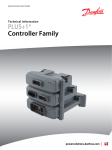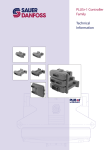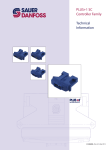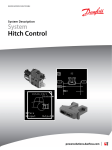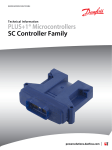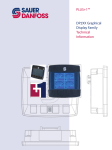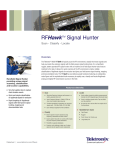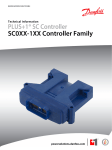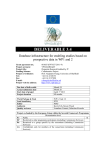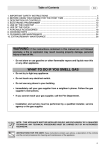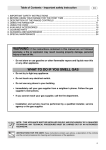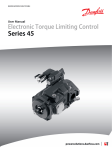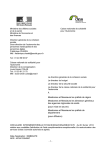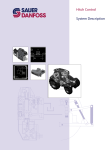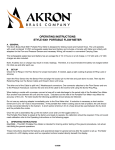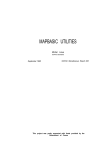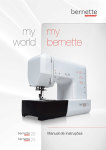Download DANFOSS PLUS+1 Controllers catalogue
Transcript
PLUS+1 Controller Family Technical Information 520L0719 • Rev NA • Mar 2013 PLUS+1 Controller Family Technical Information Revisions Revision History Table of Revisions Date 11 Mar 2013 30 Jan, 2013 10 Dec, 2012 28 Nov, 2011 31 Aug, 2010 8 Oct, 2009 23 June, 2009 16 June, 2009 02 June, 2009 23 Oct, 2008 21 Jul, 2008 25 Sep, 2007 24 Sep, 2007 24 Oct, 2006 21 Sep, 2006 29 Jun, 2005 24 Mar, 2004 Page 24 12 Various Various, 13, 15, 18, 24, 27 Changed Added a note regarding the service tool scan Note regarding MC050-010, Pin C1-P26 MC018; MC012-026/029 controller updates General content update, various pages; new Warning, page 13 and 18; output pins available table updated, page 15; FRAM memory, page 24; contacts pin module part numbers corrected, page 27. 6—11, 16, 18, 20, Removed PLUS+1 Module Naming Covention topic. Revised 23-27 content in topics: Inputs, Outputs, CAN Ports, Environmental Testing Criteria, and Sauer-Danfoss Crimp Extraction Tool Part Information. General content update and corrections. 6, 8, 10, 15-19, Content in topics: PLUS+1 Module Naming Covention, Inputs, 25—26, 29 Outputs, Environmental Testing Criteria, Recommended Machine Wiring Guidelines 13, 23 Correction regarding IX modules; MC050-055 Specifications table 3, 6, 15, 18, 20, 21 General; and updated Memory /Communication Resources table Various MC038-010, MC050-55 modules added All Literature order number corrected at bottom of pages Various General content update 21 Corrected typo Various Specifications update, added 88 pin module 14 Paragraph added re: maximum current; specifications 5, 7—22 Specifications General content update First edition Rev. NA MA LA KA JA IA HB HA GA FB FA EB EA D C B A © 2013 Sauer-Danfoss. All rights reserved. Sauer-Danfoss accepts no responsibility for possible errors in catalogs, brochures and other printed material. Sauer -Danfoss reserves the right to alter its products without prior notice. This also applies to products already ordered provided that such alterations can be made without affecting agreed specifications. All trademarks in this material are properties of their respective owners. Sauer-Danfoss, the Sauer-Danfoss logotype, the Sauer-Danfoss S-icon, PLUS+1™, What really matters is inside® and Know-How in Motion™ are trademarks of the Sauer-Danfoss Group. 2 520L0719 • Rev NA • Mar 2013 PLUS+1 Controller Family Technical Information Contents Product Overview About This Manual.......................................................................................................................................... 5 PLUS+1 Controller Family Technical Information........................................................................... 5 What information is in this manual?................................................................................................... 5 What information is in individual module product data sheets?............................................. 5 What information is in individual module API specifications?.................................................. 5 What information is in the PLUS+1 GUIDE Software User Manual?........................................ 5 PLUS+1 Family of Mobile Machine Management Products............................................................ 6 User Liability and Safety Statements........................................................................................................ 6 OEM Responsibility................................................................................................................................... 6 Inputs/Outputs Types and Specifications Inputs................................................................................................................................................................... 7 Input Types................................................................................................................................................... 7 Digital (DIN)................................................................................................................................................. 7 Analog (AIN)................................................................................................................................................. 8 Analog Input Offset................................................................................................................................... 8 A/D Refresh Rate........................................................................................................................................ 9 Analog/Temperature/Rheostat (AIN/Temp/Rheo); Digital/Analog/Frequency/Rheostat (Din/AIN/FreqIN/Rheo)..........................................................................................................................10 Digital/Analog/Frequency (DIN/AIN/FreqIN); Digital/Analog/Frequency/Rheostat (Din/AIN/FreqIN/Rheo) (All modules except IX012-010, IX024-010).....................................11 Digital/Analog/Frequency (DIN/AIN/FreqIN) (IX012-010, IX024-010 modules)................12 Digital/Analog/4-20 mA (DIN/AIN/4-20 mA IN)............................................................................14 Outputs.............................................................................................................................................................15 Output Types.............................................................................................................................................15 Digital (DOUT) and Digital/PVG Reference Power (DOUT/PVEpwr)......................................16 High Current Digital (HDOUT).............................................................................................................17 Pulse Width Modulated (PWMOUT/DOUT/PVGOUT).................................................................18 High Current Pulse Width Modulated (HPWMOUT/DOUT)......................................................19 MC038-010, MC088-XXX Output Pin Power Supply....................................................................19 Controller Area Network Specifications CAN (Controller Area Network) Ports . ..................................................................................................20 System Design..........................................................................................................................................20 Terminating Resistor...............................................................................................................................20 CAN Bus Installation...............................................................................................................................20 Expansion Module CAN Bus Loading.....................................................................................................21 Product Ratings Power.................................................................................................................................................................22 Module Supply Voltage/Maximum Current Ratings...................................................................22 MC038-010 Power Supply....................................................................................................................22 MC038-010 Sleep Mode........................................................................................................................22 Sensor Power Supply Ratings..............................................................................................................23 PVG Valve Power Supply........................................................................................................................24 EEPROM Write/Erase.....................................................................................................................................24 Ratings.........................................................................................................................................................24 Vault Memory............................................................................................................................................24 Environmental Testing Criteria.................................................................................................................25 General Product Ratings.......................................................................................................................25 PLUS+1 Module Environmental Testing Criteria...........................................................................25 Modules Housing.....................................................................................................................................26 520L0719 • Rev NA • Mar 2013 3 PLUS+1 Controller Family Technical Information Contents Product Installation and Start-up General Comments.......................................................................................................................................27 Mating Connectors..................................................................................................................................27 Product Installation......................................................................................................................................28 Mounting....................................................................................................................................................28 Machine Diagnostic Connector..........................................................................................................28 Grounding..................................................................................................................................................28 Hot Plugging.............................................................................................................................................28 Recommended Machine Wiring Guidelines..................................................................................29 Recommended Machine Equipped with PLUS+1 Module Welding Procedures .............29 PLUS+1 USB/CAN Gateway..................................................................................................................30 4 520L0719 • Rev NA • Mar 2013 PLUS+1 Controller Family Technical Information Product Overview About This Manual PLUS+1 Controller Family Technical Information This manual is designed to be a comprehensive PLUS+1™ product family hardware module reference tool for vehicle OEM design, engineering, and service personnel. It is one of four sources of PLUS+1 product technical information. Other sources include individual module product data sheets, module specific Application Program Interface (API) specifications and the PLUS+1 GUIDE Software User Manual, literature number 10100824. What information is in this manual? This manual describes unique characteristics of specific PLUS+1 modules and electrical details that are common to all PLUS+1 modules, including general specifications, input and output parameters, environmental ratings and installation details. What information is in individual module product data sheets? Parameters that are unique to an individual PLUS+1 module are contained in the module product data sheet. Data sheets contain the following information: • Numbers and types of inputs and outputs • Module connector pin assignments • Module maximum current capacity • Module sensor power supply (if present) current capacity • Module installation drawing • Module weights • Product ordering information Module API specifications are the definitive source of information regarding PLUS+1 module pin characteristics. PLUS+1 product literature is available at: www.sauer-danfoss.com What information is in individual module API specifications? Detailed information about the module BIOS is contained in the module API specification. PLUS+1 BIOS functionality is pin dependent. Pins are defined in module data sheets as C (connector number) p (pin number). API specifications include: • Variable name • Variable data type • Variable direction (read/write) • Variable function and scaling What information is in the PLUS+1 GUIDE Software User Manual? Detailed information regarding the PLUS+1 GUIDE software tool set that is used to build PLUS+1 machine management solutions is contained in the user manual. This technical information manual covers the following broad topics: • How to use the GUIDE graphical application development tool to create machine applications • How to configure module input and output parameters • How to download GUIDE applications to target PLUS+1 hardware modules • How to upload and download tuning parameters • How to use the PLUS+1 service tool 520L0719 • Rev NA • Mar 2013 5 PLUS+1 Controller Family Technical Information Product Overview PLUS+1 Family of Mobile Machine Management Products 12, 18, 24, 38, 50, and 88 Pin Models F101753 PLUS+1 controllers and input/output expansion modules are designed to provide flexible, expandable, powerful, and cost effective total machine management systems for off-highway vehicles. These modules communicate with one another and other intelligent systems over a machine Controller Area Network (CAN) data bus. PLUS+1 hardware products are designed to be equally effective in a distributed CAN system, with intelligence in every node, or as stand-alone control for smaller machine systems. PLUS+1 systems are incrementally expandable: additional modules can be easily added to the machine CAN bus to increase system capabilities or computational power. PLUS+1 control products utilize modular designs wherever possible. This modularity extends to product housings, connectors and control circuitry. Five standard housings, 12, 18, 24, 38, 50, and 88 pin, cover the entire product line. User Liability and Safety Statements OEM Responsibility The OEM of a machine or vehicle in which PLUS+1 electronic controls are installed has the full responsibility for all consequences that might occur. Sauer-Danfoss has no responsibility for any consequences, direct or indirect, caused by failures or malfunctions. • Sauer-Danfoss has no responsibility for any accidents caused by incorrectly mounted or maintained equipment. • Sauer-Danfoss does not assume any responsibility for PLUS+1 products being incorrectly applied or the system being programmed in a manner that jeopardizes safety. • All safety critical systems shall include an emergency stop to switch off the main supply voltage for the outputs of the electronic control system. All safety critical components shall be installed in such a way that the main supply voltage can be switched off at any time. The emergency stop must be easily accessible to the operator. 6 520L0719 • Rev NA • Mar 2013 PLUS+1 Controller Family Technical Information Inputs/Outputs Types and Specifications Each PLUS+1 hardware module has input or output pins that support multiple functions. Pins that support multiple input or output types are user-configurable using PLUS+1 GUIDE software. Refer to controller data sheets for the input/output (I/O) content of individual modules. Inputs Input Types • Digital (DIN) • Digital or Analog (DIN/AIN) • Analog or Temperature or Rheostat (AIN/Temp/Rheo) • Multifunction: Digital or Analog or Frequency (DIN/AIN/FreqIN) • Multifunction: Digital or Analog or Frequency or Rheostat (DIN/AIN/FreqIN/Rheo) • Fixed Range Analog or CAN shield (AIN/CAN shield) • Digital or Analog or Current (DIN/AIN/4-20 mA IN) Each PLUS+1 Module input pin supports one of the above functional types. For pins with multiple functions, input configurations are user programmable using PLUS+1 GUIDE templates. Digital (DIN) Digital inputs connected to PLUS+1 dedicated digital input pins are debounced in software. Digital input debounce is defined as an input being in a given state for three samples before a state change is reported. The sample time is a function of application loop time. Multifunction pins that are configured to be DIN are subject to the same update rates as the analog input function for that pin. Debounce is not used, as hysteresis is built into the function. The time to recognize a transition is dependent on the timing of the switch activation and the sample rate. General Description Response to input below minimum voltage Response to input above maximum voltage Response to input open Voltage working ranges Comment Non-damaging, non-latching; reading saturates to the low limit. Non-damaging, non-latching; reading saturates to the high limit. Pin configuration dependent: No pull up/ no pull down = floating Pull up to 5 Vdc = 5 Vdc Pull down = 0 Vdc Pull up/ pull down = 2.5 Vdc Programmable (see specific data sheets for ranges). Specifications Description Allowed voltage at pin Units Vdc Minimum 0 Rising voltage threshold Vdc 2.80 520L0719 • Rev NA • Mar 2013 Maximum Comment 36 Modules will survive with full functionality if input voltage does not exceed 36 Vdc. 4.15 A digital input is guaranteed to be read as high if the voltage is greater than 4.15 Vdc. 7 PLUS+1 Controller Family Technical Information Inputs/Outputs Types and Specifications Inputs (continued) Digital (DIN) (continued) Specifications (continued) Description Falling voltage threshold Units Vdc Minimum 1.01 Maximum Comment 2.77 A digital input is guaranteed to be read as low if the voltage is less than 1.01 Vdc. 1.5 Input change from maximum to minimum—add to debounce time. Time to change state in response to step input Input impedance Input voltage < 5.7 Vdc ms kΩ 233 nominal—no pull up or pull down pin configuration. Input impedance Input voltage < 5.7 Vdc kΩ 14.1 nominal—pull up or pull down pin configuration. Input impedance Input voltage ≥ 5.7 Vdc kΩ 14.1 nominal—all pin configurations. Analog (AIN) Specifications Description Units Minimum Maximum Comment Allowed voltage at pin * Vdc 0 36 0 to 5 Vdc range Vdc 5.21 5.30 5.26 is typical. Maximum discernable voltage 0 to 36 Vdc range Vdc 31.70 Maximum discernable voltage Precision mV 1.28 Input impedance kΩ 206 236 Depends on pin configuration. * Maximum allowed voltage on fixed range analog input pins (CAN shield) is 25 Vdc. Analog Input Offset Module analog input offset error can be 80 counts out of 4096 (12 bit resolution). Therefore, the minimum voltage that a module will read at the 0 to 5.25 Vdc range is 105 mV. The minimum voltage that a module will read at the 0 to 36 Vdc range is 703 mV. The input offset error is a function of component tolerances and can vary from one module to the next. When an input value is used in an algorithm where the offset error could impact the control strategy, the way the signal is acquired and the need to calibrate should be considered. 8 520L0719 • Rev NA • Mar 2013 PLUS+1 Controller Family Technical Information Inputs/Outputs Types and Specifications Inputs (continued) A/D Refresh Rate Analog to Digital (A/D) refresh rates for individual PLUS+1 modules are as follows. A/D channels are sampled at 25 kHz and 64 samples are taken to build an average value. This results in a refresh rate of 2.56 ms for channels directly measured. All internal current feedback channels are refreshed at the 2.56 ms rate. Some PLUS+1 module A/D channels are shared. Each of the shared channels has eight multiplexed analog inputs. Each multiplexed input is serviced every 20.48 ms. Update rates for specific analog input pins are found below. Update rates for input expander modules are dependent on the CAN message frequency selected in the application program. A/D Refresh Rates for PLUS+1 Modules PLUS+1 module MC012-010/012 MC012-026/029 MC018-010/012 MC024-010/011/012/014 MC024-020/021/022/024 MC024-500 MC038-010 MC050-010/012 MC050-020/022 MC050-055/05B MC088-015/01B/315 IOX012-010 IOX024-020 IX012-010 IX024-010 520L0719 • Rev NA • Mar 2013 A/D refresh rate All: 2.56 ms All: 2.56 ms All: 2.56 ms All: 2.56 ms C1p10 to C1p12: 7.68 ms Remaining pins: 2.56 ms All: 2.56 ms C1p08, C1p14, C1p17 to C1p20, C1p24 to C1p27, C1p36 to C1p38: 20.48 ms C1p05, C1p10 to C1p12: 2.56 ms C1p05, C1p08, C1p14 to C1p19, C1p22 to C1p30, C1p34 to C1p36: 20.48 ms C1p02: 2.56 ms C1p05, C1p22, C1p25 to C1p32, C1p39, C1p40: 20.48 ms C1p02, C1p08, C1p18, C1p19, C1p23, C1p24: 2.56 ms C1p05, C1p13 to C1p29, C1p31 to C1p39, C1p41 to C1p45: 20.48 ms C1p46 to C1p49: 2.56 ms C1p05, C1p08, C1p14 to C1p19, C1p22 to C1p30, C1p34 to C1p36, C1p47 to C1p50 , C2p09 to C2p11, C2p35 to C2p38: 20.48 ms Refresh rate is a function of CAN message frequency Refresh rate is a function of CAN message frequency Refresh rate is a function of CAN message frequency Refresh rate is a function of CAN message frequency 9 PLUS+1 Controller Family Technical Information Inputs/Outputs Types and Specifications Inputs (continued) Analog/Temperature/Rheostat (AIN/Temp/Rheo); Digital/Analog/Frequency/Rheostat (Din/AIN/FreqIN/Rheo) When a PLUS+1 module input pin is configured in the temperature/rheostat mode, the input has a 1.33 kΩ pull up resistor to +5 Vdc. It will source up to 3.75 mA current to an external load (RL) which then can be measured. The equation for relating AD counts to a given load is: AD counts = (4096*RL) / (RL + 1330). This calculation is solved internally and the ohms value is available for the programmer. The following chart shows the relationship between AD counts and load resistance in ohms. Rheostat Inputs 4000 AD Counts 3500 3000 2500 2000 1500 1000 500 0 0 1000 2000 3000 4000 5000 6000 7000 8000 9000 10000 Load Resistance (Ω) Specifications Description Allowed voltage at pin Measured resistance 10 520L0719 • Rev NA • Mar 2013 Units Vdc Ω Minimum 0 0 Maximum Comment 36 10000 P108013 PLUS+1 Controller Family Technical Information Inputs/Outputs Types and Specifications Inputs (continued) Digital/Analog/Frequency (DIN/AIN/FreqIN); Digital/Analog/Frequency/Rheostat (Din/AIN/FreqIN/Rheo) (All modules except IX012-010, IX024-010) The characteristics of Digital/Analog/Frequency pins are GUIDE software controlled. The input can be digital, analog or frequency. Inputs can be pulled to 5 Vdc, pulled to ground, pulled to 2.5 Vdc, or no pull-up/pull-down. General Description Response to input below minimum voltage Response to input above maximum voltage Expected measurement Comment Non-damaging, non-latching; reading saturates to the low limit. Non-damaging, non-latching; reading saturates to the high limit. Frequency (Hz) Period (0.1 µsec) Channel to channel phase shift (paired inputs . . . ) (0.1 ms). PWM duty cycle (0.01%)— Duty cycle measurement only valid up to 5 kHz (FreqIN). Edge count. Quadrature count (paired inputs driven from a quadrature encoder). Pull up/pull down configuration No pull down/ pull up is standard with pull up or pull down programmable; failure modes are detectable. As with analog input pins, values in the following table assume software compensation for AD converter offset errors. Specifications Description Allowed voltage at pin Frequency range Maximum discernable voltage (high range) Maximum discernable voltage (middle range) Maximum discernable voltage (low range) Precision (high range) Worst case error (high range) Precision (middle range) Worst case error (middle range) Precision (low range) Worst case error (low range) Input impedance (pulled to 5 Vdc or ground, middle and low range) Input impedance (pulled to 2.5 Vdc middle and low range) Input impedance (no pull ups, middle and low range) Input impedance (pulled to 5 Vdc or ground, high range) Input impedance (pulled to 2.5 Vdc high range) Input impedance (no pull ups, high range) 520L0719 • Rev NA • Mar 2013 Units Vdc Hz Vdc Vdc Vdc mV mV mV mV µV mV kΩ Minimum 0 0 34.62 5.18 0.360 –– –– –– –– –– –– 13.9 Maximum 36 10000 35.91 5.33 0.375 8.62 614 1.28 75 89.7 7.39 14.3 kΩ 7.17 7.37 kΩ 230 236 kΩ 13.0 13.4 kΩ kΩ 6.92 108 7.12 112 Comment In steps of 1 Hz. 35.3 Vdc is typical. 5.26 Vdc is typical. 0.368 Vdc is typical. 11 PLUS+1 Controller Family Technical Information Inputs/Outputs Types and Specifications Inputs (continued) Digital/Analog/Frequency (DIN/AIN/FreqIN); Digital/Analog/Frequency/Rheostat (Din/AIN/FreqIN/Rheo) (All modules except IX012-010, IX024-010) (continued) MC050-010 Pin C1p26 should not be configured as a FreqIN. Specifications (continued) Recommendation is to not use pin C1p26 as a frequency input. If used, recommendation is to disable internal filtering and use filter inside the application instead. Description Rising voltage threshold (high range) Units Vdc Minimum 18.9 Falling voltage threshold (high range) Vdc 6.8 Rising voltage threshold (middle range) Vdc 2.92 Falling voltage threshold (middle range) Vdc 1.02 Rising voltage threshold (low range) Vdc 0.197 Falling voltage threshold (low range) Vdc 0.071 Maximum Comment 27.6 It is inadvisable to use the high range option when configuring the input as a digital or frequency input. 18.5 It is inadvisable to use the high range option when configuring the input as a digital or frequency input. 4.12 A digital input is guaranteed to be read as high if the voltage is greater than 3.99 Vdc. These numbers also apply to frequency. 2.75 A digital input is guaranteed to be read as low if the voltage is less than 0.96 Vdc. These numbers also apply to frequency. 0.298 A digital input is guaranteed to be read as high if the voltage is greater than 0.28 Vdc. 0.192 A digital input is guaranteed to be read as low if the voltage is greater than 0.067 Vdc. Digital/Analog/Frequency (DIN/AIN/FreqIN) (IX012-010, IX024-010 modules) The characteristics of Analog/Digital/Frequency pins are GUIDE software controlled. The input can be digital, analog or frequency. Inputs can be pulled to 5 Vdc, pulled to ground, or pulled to 2.5 Vdc. Analog to digital resolution is 10 bits. As with analog input pins, values in the following table assume software compensation for the errors in the AD converter. Specifications Description Allowed voltage at pin Frequency range Maximum discernable voltage (high range) Maximum discernable voltage (middle range) Maximum discernable voltage (low range) Minimum discernable voltage Precision (high range) Worst case error (high range) Precision (middle range) Worst case error (middle range) Precision (low range) Worst case error (low range) Input impedance (pulled to 5 Vdc or ground, middle and low range) 12 520L0719 • Rev NA • Mar 2013 Units Vdc Hz Vdc Minimum 0 0 35.3 Maximum Comment 36 10000 In steps of 1 Hz. 36 36 Vdc is typical. Vdc 5.67 5.83 5.75 Vdc is typical. Vdc 0.440 0.456 0.448 Vdc is typical. Vdc mV mV mV mV µV mV kΩ 0 –– –– –– –– –– –– 13.9 0.08 36.5 614 5.62 75 438 7.39 14.3 PLUS+1 Controller Family Technical Information Inputs/Outputs Types and Specifications Inputs (continued) Digital/Analog/Frequency (DIN/AIN/FreqIN) (IX012-010, IX024-010 modules) (continued) Specifications (continued) Description Input impedance (pulled to 2.5 Vdc middle and low range) Input impedance (no pull ups, middle and low range) Input impedance (pulled to 5 Vdc or ground, high range) Input impedance (pulled to 2.5 Vdc high range) Input impedance (no pull ups, high range) Units kΩ Minimum 7.17 Maximum Comment 7.37 kΩ 230 236 kΩ 10.3 10.7 kΩ 6.07 6.27 kΩ 36.4 38.4 This table shows the rising and falling thresholds when the input is used as a digital or frequency input. Specifications Description Rising voltage threshold (high range) Units Vdc Minimum –– Falling voltage threshold (high range) Vdc –– Rising voltage threshold (middle range) Vdc 2.85 Falling voltage threshold (middle range) Vdc 1.15 Rising voltage threshold (low range) Vdc 0.22 Falling voltage threshold (low range) Vdc 0.090 Maximum Comment –– It is inadvisable to use the high range option when configuring the input as a digital or frequency input. –– It is inadvisable to use the high range option when configuring the input as a digital or frequency input. 4.03 A digital input is guaranteed to be read as high if the voltage is greater than 4.03 Vdc. These numbers also apply to frequency. 2.59 A digital input is guaranteed to be read as low if the voltage is less than 1.15 Vdc. These numbers also apply to frequency. 0.31 A digital input is guaranteed to be read as high if the voltage is greater than 0.31 Vdc. 0.20 A digital input is guaranteed to be read as low if the voltage is greater than 0.090 Vdc. Potential for IX modules to not go online. If voltage is applied to an IX module input pin prior to the module being powered on, there is a possibility that the module CPU will not power up. The module is not damaged and will power up and operate normally once power is removed from the input pins. It is recommended that either the IX module’s 5 Vdc sensor power be used to power sensors or that power is removed from the input pins until the module is powered up. If the frequency goes to zero, the data will not decay over time, it will be updated once a new pulse is seen, or times out. It is possible to monitor the count of pulses to know when the frequency reading is updated. 520L0719 • Rev NA • Mar 2013 13 PLUS+1 Controller Family Technical Information Inputs/Outputs Types and Specifications Inputs (continued) Digital/Analog/4-20 mA (DIN/AIN/4-20 mA IN) Refer to Analog/Digital/Frequency Specifications table, page 12, for input properties when pins are configured as digital, analog or frequency. If the pin is configured to read current, the table below applies. When interfacing with sensors that transmit a 4 to 20 mA current signal, the positive lead of the transmitter is connected to battery voltage and the negative lead is connected to the PLUS+1 module pin. The current measuring configuration relies on the application program to provide over current protection. The current measuring configuration is only available on MC088-XXX modules. Specifications Description Allowed voltage at pin Minimum input current Maximum input current Precision 14 520L0719 • Rev NA • Mar 2013 Units Vdc mA mA µA Minimum 0 3 20 Maximum Comment 36 4 24 5.86 PLUS+1 Controller Family Technical Information Inputs/Outputs Types and Specifications Outputs Output Types • Digital (DOUT) • Digital/PVG valve reference power (DOUT/PVGpwr) • High current digital (HDOUT) • Pulse width modulated (PWM/DOUT/PVGOUT) • High current (6 A) pulse width modulated (HPWMOUT/DOUT) • High current (10 A) pulse width modulated (HPWMOUT/DOUT) Output Pins Available on Individual PLUS+1 Modules PLUS+1 Module MC012-010/012 MC012-026/029 MC018-010/012 MC024-010/011/012/014 MC024-020/021/022/024 MC038-010 MC050-010/012 MC050-020/022 MC050-055/05B MC088-015/01B IOX012-010 IOX024-020 PWMOUT/ DOUT/ DOUT/ DOUT DOUT HDOUT PVGpwr PVGOUT (2A) (3 A) (6 A) (3 A) (3 A) 2 HPWMOUT/ DOUT (10 A) 3 5 2 2 4 8 4 2 3 3 6 1 13 3 2 6 3 OX012-010 OX024-010 HPWMOUT/ DOUT (6 A) 10 6 2 10 2 8 6 4 2 10 PLUS+1 control modules feature user-configurable output pin parameters. Output pin parameters are configured using PLUS+1 GUIDE templates. Refer to module data sheets for maximum output current ratings of individual modules and MC038-010 and MC088-015/01B power planes. The total output current for any PLUS+1 module must not exceed the maximum allowable current specified in the module data sheet. In the case of MC038-010 and MC088-015/01B modules, both the total output current for an individual power plane and the total output for the module must not exceed the limits specified on the module data sheets. Warning Unintended movement of the machine or mechanism may cause injury to the technician or bystanders. The module will be powered up if battery voltage is applied to the module’s output pin. To protect against unintended movement, secure the machine. Caution Warranty will be voided if module is damaged by significant current driven back through an output pin. 520L0719 • Rev NA • Mar 2013 15 PLUS+1 Controller Family Technical Information Inputs/Outputs Types and Specifications Outputs (continued) Digital (DOUT) and Digital/PVG Reference Power (DOUT/PVEpwr) Digital outputs can source up to 3 A. The exception is MC038-010 controller, DOUT pins are limited to 2 A. • Current outputs for MC050-010, MC050-020, MC088-015, and OX024-010 module DOUT and DOUT/PVG Pwr pins are pair limited and a function of temperature. Output per pair is: 6 A maximum at 25° C [77˚ F]. Output per pair is 4 A maximum at 70° C [158˚ F] • MC050-010 pairs are: C1p31 and C1p32, C1p33 and C1p34, C1p35 and C1p36 • MC050-020 pairs are: C1p33 and C1p34, C1p35 and C1p36, C1p37 and C1p38, C1p39 and C1p40 • MC088-015 pairs are: Power plane C2p35: Power plane C2p36: Power plane C2p37: Power plane C2p38: • C1p31 and C1p32, C1p33 and C1p34 C1p35 and C1p36 C2p1 and C2p7, C2p2 and C2p3, C2p4 and C2p5, C2p30 and C2p33 C2p6 and C2p12 OX024-010 pairs are: C1p6 and C1p7, C1p8 and C1p9, C1p10 and C1p11 • Example: at a module temperature of 70˚ C [158˚ F], if C1p31 is sourcing 2.5 A, the most current that can be sourced on its paired pin C1p32 is 1.5 A General Description Configuration Type Short circuit to ground protection Comment Sourcing only. Linear switching. Non-damage, current/thermal limit with status indication; automatic latch off /resume. Fault indication provided. The GUIDE Pin Status requires a load of 500 mA to be connected or an open fault will be declared. Digital outputs from the same module are capable of being connected together such that the net current rating is the sum of the individual ratings; timing is resolved by the operating system; diagnostic capability is maintained. Processor control with hardware WatchDog override. Open circuit detection Parallel operation Shut off Specifications Description Allowed voltage at pin Output voltage, energized state Output voltage, off state Output current range for a status bit to read OK Units Vdc Vdc Vdc A Minimum 0 Vbatt-1.0 0 0.5 Maximum 36 Vbatt 0.1 3 Comment See caution statement, page 17. Over all load conditions. At Rload=200 Ω See note regarding pair, above. Do not connect a digital output to battery+ (back drive) without a series diode. 16 520L0719 • Rev NA • Mar 2013 PLUS+1 Controller Family Technical Information Inputs/Outputs Types and Specifications Outputs (continued) High Current Digital (HDOUT) High current digital outputs can source up to 6 A. General Description Configuration Type Short circuit to ground protection Comment Sourcing only. Linear switching. Non-damage, current/thermal limit with status indication; automatic latch off/resume. Status indication provided. The GUIDE pin status requires a load of 1000 mA to be connected or an open status will be declared. Digital outputs from the same module are capable of being connected together such that the net current rating is the sum of the individual ratings: timing is resolved by the operating system and diagnostic capability is maintained. Processor control with hardware Watchdog override. Open circuit detection Parallel operation Shut off Specifications Description Allowed voltage at pin Output voltage, energized state Output voltage, off state Output current range for status bit to read OK Units Vdc Vdc Vdc A Minimum 0 Vbatt-1.0 0 1 Maximum 36 Vbatt 0.1 6 Comment See caution statement below. Over all load conditions. At Rload=200 Ω See pair comment above. Warning Unintended movement of the machine or mechanism may cause injury to the technician or bystanders. DOUT and HDOUT digital outputs do not have an internal feedback to the PLUS+1 module kernel. To protect against unintended movement, if the application requires fault detection, an external feedback using an AIN configured pin must be used. External feedback is required if the actual output is to be read by the PLUS+1 Service Tool. All other output types have internal feedback to the PLUS+1 module kernel that provide pin fault and status information that can be read directly by the application and the PLUS+1 Service Tool. 520L0719 • Rev NA • Mar 2013 17 PLUS+1 Controller Family Technical Information Inputs/Outputs Types and Specifications Outputs (continued) Pulse Width Modulated (PWMOUT/DOUT/PVGOUT) All PLUS+1 Module proportional outputs are Pulse Width Modulated (PWM). PWM frequency is software adjustable using GUIDE. A low frequency dither may also be added with software to some outputs (see individual module API specifications for PWM outputs that support dither). There are two modes of PWM operation: open loop and closed loop (current control). In open loop mode, current can be sourced or sunk (all modules are limited to 8 amps sinking), but the output is a PWM duty cycle. Current feedback may be monitored in open loop mode, but the output is a constant voltage, not a constant current. PVG valves may be driven with open loop PWM. In closed loop mode, current is sourced and a constant current is maintained by the module’s operating system using internal current feedback. Load impedance must not exceed 65 ohms. In closed loop mode, the maximum current is limited by measuring the feedback current. There is no thermal protection. If the maximum current is exceeded, the controller kernel will shut down the output and latch it. The kernel also limits how quickly the output can be repowered (250 ms). The output cannot be reset until the command goes to 0 or False (if configured as a digital output). Proportional outputs that are used as a digital sinking output have a potential for a leakage current of up to 5 mA when off. Refer to individual module data sheets for the maximum allowable output current for each PLUS+1 module. General Description Configuration Type (Linear vs. PWM) Operating modes Dual coil PCPs Short circuit to ground Mode selection (current or voltage) and full scale current ranges Comment Sourcing or sinking. PWM Programmable: closed loop current or open loop voltage (duty cycle). Compensated for induced currents in a non-driven coil (closed loop mode). Output fully protected against damage and fault detected. Programmable. Do not connect a digital output to battery+ (back drive) without a series diode. PLUS+1 PWM output circuits are not designed to be used as inputs. Output current feedback readings should be used for fault checking only. Warning Unintended movement of the machine or mechanism may cause injury to the technician or bystanders. The module will be powered up if battery voltage is applied to the module’s output pin. To protect against unintended movement, secure the machine. Caution Warranty will be voided if module is damaged by significant current driven back through an output pin. 18 520L0719 • Rev NA • Mar 2013 PLUS+1 Controller Family Technical Information Inputs/Outputs Types and Specifications Outputs (continued) Pulse Width Modulated (PWMOUT/DOUT/PVGOUT) (continued) Specifications Description Full scale proportional current output Units mA Minimum 10 Output voltage, 100% duty cycle Output resolution of 3 A Repeatability of full range 0 Output settling time PWM frequency Vdc mA % of full scale % of full scale ms Hz 33 100 4000 Dither frequency Dither amplitude Over-current trip point Hz A A 33 0 5 250 0.5 5.25 Absolute accuracy of full range Maximum Comment 3000 The current may accidently be exceeded in open loop mode. If the current exceeds the trip point, the output will be latched off. Vbatt-1 0.25 0.5 0.5 Depends on load characteristics. Some pins have a fixed frequency, consult module application program interface (API). Increased in steps, see module API. Increased in steps, see module API. There is over-current protection built into each output driver. If the instantaneous current exceeds the trip point, the driver is latched off. GUIDE application software can reset the latch and attempt to drive current again. High Current Pulse Width Modulated (HPWMOUT/DOUT) High current proportional outputs are unique to the MCO38-010 controller. These outputs are PWM, with PWM frequency user-configurable using PLUS+1 GUIDE. The MC038-010 has two types of high current PWM outputs: Paired bi-directional PWMs (10 A) that can be configured as either H bridges or independent outputs and sourcing only PWMs (one 10 A and six 6 A). See the product data sheet and API documents for pair assignments. All high current proportional outputs are operated as open loop. The controller kernel does, however, monitor current for circuit protection, but there is no current feedback to the application. The output is a constant voltage and not a constant current. PWM outputs are hardware protected from short or over current. Specifications Description Over-current trip point, 6 A Over-current trip point, 10 A PWM frequency The controller DSP will be powered if power is supplied to any one of the controller’s power planes. Units A A Hz Minimum 33 Maximum Comment 12 Temperature dependent. 18 Temperature dependent. 4000 MC038-010, MC088-XXX Output Pin Power Supply The output pin power supply design of the MC038-010 and MC088-XXX controllers is different from that of other PLUS+1 modules. MC038-010 and MC088-XXX controllers have discrete power supply planes for output pins and a separate dedicated power supply for the DSP. Each output pin is associated with a specific power supply plane. Refer to the controller data sheets for a map of outputs and their associated power plane. 520L0719 • Rev NA • Mar 2013 19 PLUS+1 Controller Family Technical Information Controller Area Network Specifications CAN (Controller Area Network) Ports System Design All PLUS+1 modules have CAN ports that conform to CAN 2.0B specifications, including CAN shield. The second (CAN1) port on MC050-010/012 and MC050-020/022 controllers may not interface with the PLUS+1 Service Tool, depending on the version of .hwd file used to build the application. MC050-010/012 .hwd files version 190 and higher allow communication with the PLUS+1 Service Tool. MC050-020/022 .hwd files version 150 and higher allow communication with the PLUS+1 Service Tool. Regardless of .hwd version, CAN1 port and CAN2 port on MC050-055/05B controllers cannot be used to download GUIDE application programs. Warning Unintended movement of the machine or mechanism may cause injury to the technician or bystanders. Machine performance may be impaired if CAN communications are disrupted by electrical fields in excess of 30 V/m between 20 and 30 MHz. To prevent potential unintended machine movement and to meet EMC requirements, a shielded CAN bus must be used to achieve 100 V/m immunity. Terminating Resistor Each end of the main backbone of the CAN bus must be terminated with an appropriate resistance to provide correct termination of the CAN_H and CAN_L conductors. This termination resistance should be connected between the CAN_H and CAN_L conductors. Specifications Description Resistance Units Ω Inductance µH Minimum 110 Maximum Nominal 130 120 Comment Minimum power dissipation 400 mW (assumes a short of 16 Vdc to CAN_H). 1 CAN Bus Installation Total bus impedance should be 60 Ω. The CAN transceiver will be damaged by any voltage outside of allowable range, (-7 to +36 Vdc), even with a very short pulse. If using shielded cable, the shield must be grounded to the machine ground at one point only; preferably at the mid-point of the CAN bus. Each PLUS+1 module CAN shield pin must be connected to the cable shield. 20 520L0719 • Rev NA • Mar 2013 PLUS+1 Controller Family Technical Information Controller Area Networks Specifications Expansion Module CAN Bus Loading System designers incorporating PLUS+1 expansion modules in their applications should be aware of PLUS+1 CAN bus loading and controller memory usage during system design. Each expansion module is associated with a PLUS+1 controller and uses part of the controller’s memory resources for inter-module communications. The table below can be used to estimate system CAN bus loading and the memory impact of I/O modules on their associated controller. Estimated Usage of Memory and Communication Resources Description Estimated module bus load (using default update and 250K bus speed) Estimated module bus load (using 70 ms updates and 250K bus speed) RAM usage on MC012-XXX RAM usage on MC018-010 RAM usage on MC024-010 RAM usage on MC024-011 RAM usage on MC038-010 RAM usage on MC050-010, MC050-020 RAM usage on MC050-055 RAM usage on MC088-010 ROM usage on MC012-XXX ROM usage on MC018-010 ROM usage on MC024-010 ROM usage on MC024-011 ROM usage on MC038-010 ROM usage on MC050-010, MC050-020 ROM usage on MC050-055 ROM usage on MC088-015 IX012-010 4% IX024-010 10% OX012-010 11% OX024-010 27% IOX012-010 11% IOX024-20 27% 2% 5% 3% 8% 4% 8% 9% 12% 9% 14% 9% 17% 9% 12% 9% 14% 9% 17% 9% 12% 9% 14% 9% 17% 9% 12% 9% 14% 9% 17% 9% 12% 9% 18% 9% 26% 1% 1% 1% 2% 1% 2% 1% 1% 1% 2% 1% 0% 1% 1% 1% 2% 1% 2% 8% 11% 12% 18% 10% 19% 8% 11% 12% 18% 10% 20% 8% 11% 12% 18% 10% 20% 3% 4% 4% 6% 3% 7% 8% 11% 12% 18% 10% 21% 3% 4% 4% 6% 3% 8% 3% 4% 4% 6% 3% 8% 3% 4% 4% 6% 3% 7% 520L0719 • Rev NA • Mar 2013 21 PLUS+1 Controller Family Technical Information Product Ratings Power Module Supply Voltage/Maximum Current Ratings PLUS+1 modules are designed to operate with a nominal 9 to 32 Vdc power supply. The modules will survive with full functionality if the supply voltage remains below 36 Vdc. Specifications Description Allowed voltage at pin Allowed module current Units Vdc A Minimum 0 0 Maximum Comment 36 Consult module data sheets for maximum allowable current. CCaution PCB damage may occur. To prevent damage to the module all module power supply + pins must be connected to the vehicle power supply to support advertised module maximum output current capacity. DO NOT use module power supply + pins to supply power to other modules on a machine. MC038-010 Power Supply The MC038-010 controller’s power supply design recommendations must be followed: • Power supply to MC038-010 controller’s output power planes (C1-p36 to C1-p38) must be wired directly to the vehicle battery and the wiring runs must be kept as short as possible. • Power supply to the controller’s DSP (C1-p2) must be wired separately from the power supply to the controller’s output power planes. • Do not connect any other PLUS+1 controllers to the power supply to MC038-010 controller’s output power planes. MC038-010 Sleep Mode Sleep mode is unique to the MC038-010 controller. This feature gives OEM designers the ability to implement automotive-like features in their machine control system design. If the sleep mode feature is not implemented, this controller has the same operating characteristics as any other PLUS+1 controller. When used as a sleep mode controller, supply power to the MC038-010 is connected directly to the battery. Sleep mode initiation is defined by the controller’s application software: PLUS+1 GUIDE programmers define the conditions under which the controller is to put to sleep. When in sleep mode, controller outputs are set to zero, sensor power supply is off and the controller consumes a small amount of current. Controller Sleep Mode Current Consumption Supply voltage 12 Vdc 24 Vdc 22 520L0719 • Rev NA • Mar 2013 Sleep mode current consumption 0.14 mA 0.28 mA PLUS+1 Controller Family Technical Information Product Ratings Power (continued) Battery power must be supplied to designated wake-up digital inputs, since the controller’s 5 Vdc regulated power supply is not available when the controller is in sleep mode. MC038-010 Sleep Mode (continued) Either of two conditions will wake up the controller: • Switching any of the designated wake-up digital inputs (DIN) in the GUIDE application, to high • Cycling all input power to the controller The following input pins may be designated as wake-up digital inputs: • DIN (C1p06, C1p07) • DIN/AIN (C1p14, C1p17 to C1p20, C1p24 to C1p27 Specifications Description Wake-up pin threshold Wake-up pin threshold Wake-up time delay Units Vdc Vdc mSec Minimum 2 4.5 250 Maximum Comment 36 To wake up by cycling input power. 36 To wake up by digital input. 500 Sensor Power Supply Ratings PLUS+1 modules that support sensor inputs are provided with dedicated regulated sensor power supply and ground pins. Refer to individual product data sheets for sensor power supply current ratings. The sensor power is nominally 5 Vdc, unless otherwise noted on the product data sheet. General Description Short circuit to ground Short circuit to battery + Comment Output is not damaged and fault is detected. Output is not damaged and fault is detected. Specifications (all modules except MC050-055/05B) Description Output short circuit voltage Output voltage Output current Units Vdc Vdc mA Output Load Capacitance Hold up time after power loss µF ms Minimum 4.88 5 Maximum Comment 36 5.12 Refer to individual data sheets for sensor power supply ratings. 10 15 MC050-055/05B controllers feature two additional levels of regulated power: 1.6 Vdc and 3.3 Vdc. The PLUS+1 GUIDE application developer can detect open and short digital inputs, when these power supplies are used in conjunction with DIN/AIN inputs. Specifications (MC050-055/05B) Description Output short circuit voltage Output voltage, sensors Units Vdc Vdc 4.88 Output voltage, DIN diagnostics Output voltage, DIN diagnostics Vdc Vdc 1.54 3.00 520L0719 • Rev NA • Mar 2013 Minimum Maximum Comment 36 5.12 Sensor power supply drops below minimum if controller power supply is less than 9 Vdc. 1.66 Nominal 1.6 3.60 Nominal 3.3 23 PLUS+1 Controller Family Technical Information Product Ratings Power (continued) PVG Valve Power Supply DOUT/PVGpwr pins can provide the battery supply voltage required by Sauer-Danfoss PVG valve electronics for those control strategies requiring application software control of the valve power source. When enabled, the DOUT/PVGpwr pin passes battery (reference) voltage to the PVG valve electronics. One DOUT/PVGpwr pin can power up to 3 PVG valves. Refer to individual module API documents for PVG power pin characteristics. EEPROM Write/Erase Ratings Specifications To prevent unexpected memory writes, care must be taken to ensure memory with a high number of read/write cycles is either U32 or S32 data types. Description EEPROM write/erase cycles (all modules except IX012-010, IX024-010) EEPROM write/erase cycles (IX012-010, IX024-010) FRAM write/erase cycles (all extended memory modules-MC0XX-XX8) Minimum 1 million Maximum Comment Minimum valid over entire operating temperature range. 10,000 Minimum valid over entire operating temperature range. 100 trillion Minimum valid over entire operating temperature range. EEPROM used in PLUS+1 controllers is rated for 1million read/write cycles per sector. Sector size is 32 bits. When a value is written to EEPROM, all 32 bits in a particular sector are always written, regardless of the size of the size of the saved value. If the value being saved in a sector is less than 32 bits (such as. U8, S16, BOLL, etc) adjacent bits in the same EEPROM sector are rewritten with their previous value. The implication of this memory property is that if two values are being written to the same memory sector, the useful life of the sector is determined by the value being written most frequently. If that value exceeds 1 million read/write cycles, all values in the sector may be compromised if the useful life is exceeded. Vault Memory Some variants of PLUS+1 modules have 2 MByte of serial flash vault memory (also referred to as application logging memory). Application developers can use this memory to log machine event data and use the PLUS+1 Service Tool to extract the logged data. As there is no real time clock on PLUS+1 modules, vault memory is not time stamped. FRAM Memory Any of the PLUS+1 extended memory controllers use FRAM memory. FRAM has a write endurance of over 100 trillion cycles. This increased write endurance is particularly ideal for datalogging. Accessing non-volatile or application log memory can delay the service tool scan. 24 520L0719 • Rev NA • Mar 2013 PLUS+1 Controller Family Technical Information Product Ratings Environmental Testing Criteria General Product Ratings Description Operating temperature Units ˚C [˚F] Minimum -40 [-40] Storage temperature ˚C [˚F] -40 [-40] Maximum Comment 70 [158] Maximum operating temperature for MC012-026/029 modules is 105° C (221° F). 85 [185] Maximum storage temperature for MC012-026/029 modules is 105° C (221° F). 36 Minimum allowable supply voltage for the MC038-010 module CPU power pin is 6 Vdc. 5.2 Sensor voltage drops below the minimum value if module supply voltage < 9 Vdc. Exception for MC050-055/05B and MC024-01A, see Sensor Power Supply Ratings, page 23. 36 Allowable module supply voltage Vdc 9 Module sensor supply voltage Vdc 4.8 Analog input voltage levels Vdc Allowable output load current (per pin) Module allowable total output current All modules Ingress Protection (IP) rating* All modules CE rating A See individual module date sheets. A See individual module data sheets. IP 67 CE compliant. * The PLUS+1 modules IP 67 rating is only valid when the module mating connector is in place and unused connector pin positions have sealing plugs installed. PLUS+1 Module Environmental Testing Criteria Climate Environment Description Storage temperature Operating temperature Thermal cycle Humidity Degree of protection Applicable standard IEC 60068-2-1, test Ab, IEC 60068-2-2 test Bb IEC 60068-2-1, test Ab, IEC 60068-2-2 test Bd IEC 60068-2-2, test Na, IEC 60068-2-38 (partial) IEC 60068-2-78, IEC 60068-2-30 test Db IEC 60529 Comment Damp heat steady state and cyclic. Chemical Environment Description Salt mist Chemical resistance Applicable standard IEC 60068-2-58 test Kb ISO 16750-5 Comment Applicable standard IEC 60068-2-6 test Fc, IEC 6008-2-64 test Fh IEC 60068-2-29 test Eb IEC 60068-2-27 test Ea IEC 60068-2-32 test Ed Comment Mechanical Environment Description Vibration Bump Shock Free fall 520L0719 • Rev NA • Mar 2013 25 PLUS+1 Controller Family Technical Information Product Ratings Environmental Testing Criteria (continued) PLUS+1 Module Environmental Testing Criteria (continued) Electrical/Electromagnetic Description EMC emission Applicable standard ISO 13766, SAE J1113-13 EMC immunity ISO 13766 Electrostatic discharge Auto electrical transients Short circuit protection EN 60-1 000-4-2 ISO 7637-2, ISO 7637-3 Sauer-Danfoss test Reversed polarity protection Sauer-Danfoss test Comment Electromagnetic compatibility for earth moving machinery. Electromagnetic compatibility for earth moving machinery. Inputs and outputs survive continuous short circuit. Normal function resumes when short is removed. Survives reverse polarity at supply voltage for at least five minutes. Modules Housing PLUS+1 module housings feature a snap together assembly that is tamper-proof. Once assembled at the factory, the housing cannot be opened for service. Opening the modules housing will void the factory warranty. 26 520L0719 • Rev NA • Mar 2013 PLUS+1 Controller Family Technical Information Product Installation and Start-up General Comments Mating Connectors PLUS+1 modules use Deutsch® connectors. Sauer-Danfoss has assembled a mating connector kit, referred to as a bag assembly, for the 12, 24, 38, 50, and 88 pin module housings. Mating connector bag assembly ordering information is found in the product data sheet for each module. Deutsch Mating Connector Part Information Description 12 pin module 18 pin module 24 pin module 38 pin module 50 pin module 88 pin module Crimp tool HDT48-00 (solid contacts) (20 to 24 AWG) HDT48-00 (solid contacts) (16 to 20 AWG) HDT48-00 (solid contacts) (20 to 24 AWG) —— HDT48-00 (solid contacts) (20 to 24 AWG) DTT20-00 (stamped contacts) (16 to 20 AWG) DTT20-00 DTT20-00 (stamped contacts) (stamped contacts) (16 to 20 AWG) (16 to 20 AWG) HDT48-00 (solid contacts) (20 to 24 AWG, 12 to 14 AWG) DTT20-00 (stamped contacts) (16 to 20 AWG) Contacts Solid: 0462-201-2031 (20 to 24 AWG) Solid: 0462-201-1631 (16 to 20 AWG) Stamped: 1062-20-0144 (16 to 20 AWG) Solid: 0462-201-2031 (20 to 24 AWG) Stamped: 0462-203-12141 Stamped: 1062-20-0144 (10 to 14 AWG) 1062-20-0144 (16 to 20 AWG) (16 to 20 AWG) Solid: 0462-201-2031 (20 to 24 AWG) Solid: 0462-201-2031 (20 to 24 AWG) Stamped: 1062-20-0144 Solid: 0462-201-12141 (16 to 20 AWG) (12 to 14 AWG) Stamped: 1062-20-0144 (16 to 20 AWG) Connector plug Gray A-Key DTM 06-12SA DT16-185B-K004 Gray A-Key DTM 06-12SA Black B-Key DTM 06-12SB DRC26-38S01-P017 DRC26-50S01 DRC26-50S01 DRC26-38S01-P017 Wedge WM-12S Not required WM-12S Not required Not required Not required Strip length 3.96 to 5.54 mm [0.156 to 0.218 in] 6.35 to 0.792 mm [0.250 to 0.312 in] 3.96 to 5.54 mm [0.156 to 0.218 in] 6.43 to 0.79 mm [0.253 to 0.031 in] 3.96 to 5.54 mm [0.156 to 0.218 in] 20 to 24 AWG: 3.96 to 5.54 mm [0.156 to 0.218 in] 12 to 14 AWG: 6.43 to 0.79 mm [0.253 to 0.031 in] Rear seal maximum insulation OD 3.05 mm [0.120 in] Sealing plugs 0413-204-2005 3.05 mm [0.120 in] 3.05 mm [0.120 in] 4.32 mm [0.17 in] 2.41 mm [0.095 in] 20 to 24 AWG: 2.41 mm [0.095 in] 12 to 14 AWG: 4.32 mm [0.17 in] 114017 0413-204-2005 114017 0413-204-2005 0413-204-2005, 114017 Sauer-Danfoss Mating Connector Part Information Description 12 pin module 18 pin module 24 pin module 38 pin module 50 pin module 88 pin module Mating connector bag assembly (20 to 24 AWG) 10100944 —— 10100945 —— 10100946 10105649 Mating connector bag assembly (16 to 20 AWG) 10102025 10102025 10102023 11027919 10102024 11071844 Sauer-Danfoss Crimp Extraction Tool Part Information Description Crimp tool for 20 to 24 AWG Crimp tool for 16 to 20 AWG Extraction tool Deutsch 114010; 12 AWG Extraction tool Deutsch 0144-240-2005; 16 to 20, 20 to 24 AWG Part number 10100745 10102028 11068808 10100744 PLUS+1 module mating connectors may be mated 10 times. Recommended torque for the Deutsch® mating connector retaining fastener on 38 and 50 pin connectors is 20 lb•in (2.26 N•m). 520L0719 • Rev NA • Mar 2013 27 PLUS+1 Controller Family Technical Information Product Installation and Start-up Product Installation Mounting PLUS+1 12, 24, 38, and 50 pin modules can be mounted in one of three ways: • End (bulkhead) installation • Up to 3 units stacked on one another • Individually side mounted MC018-XXX modules are designed for panel mounting only. MC088-XXX modules are designed for bulkhead mounting only. In each case, care must be taken to insure that the module connector is positioned so that moisture drains away from the connector. If the module is side or stack mounted, provide a drip loop in the harness. If the module is mounted vertically, the connector should be on the bottom of the module. Provide strain relief for mating connector wires. CCaution Module damage may occur. Use caution when installing MC050-XXX modules. Due to the size of the mating connector wire bundle, it is possible to twist off the end cap of the module if excessive pressure is applied during the installation of harness strain relief. Suggested Fasteners and Recommended Installation Torque Mounting method Recommended OD Bulkhead mount; multiple units stacked; single 6.0 mm (.25 in) Recommended torque 9.49 N•m (7 ft•lb) Machine Diagnostic Connector It is recommended that a diagnostic connector be installed on machines that are controlled by PLUS+1 modules. The connector should be located in the operator’s cabin or in the area where machine operations are controlled and should be easily accessible. Communication (software uploads and downloads and service and diagnostic tool interaction) between PLUS+1 modules and personal computers is accomplished over the vehicle CAN network. The diagnostic connector should tee into the vehicle CAN bus and have the following elements: • CAN + • CAN • CAN shield Grounding Proper operation of any electronic control system requires that all control modules including displays, microcontrollers and expansion modules be connected to a common ground. A dedicated ground wire of appropriate size connected to the machine battery is recommended. Hot Plugging Machine power should be off when connecting PLUS+1 modules to mating connectors. 28 520L0719 • Rev NA • Mar 2013 PLUS+1 Controller Family Technical Information Product Installation and Start-up Product Installation (continued) Recommended Machine Wiring Guidelines 1. All wires must be protected from mechanical abuse. Wires should be run in flexible metal or plastic conduits. 2. Use 85˚ C [185˚ F] wire with abrasion resistant insulation. 105˚ C [221˚ F] wire should be considered near hot surfaces. 3. Use a wire size that is appropriate for the module connector. 4. Separate high current wires such as solenoids, lights, alternators or fuel pumps from sensor and other noise-sensitive input wires. 5. Run wires along the inside of, or close to, metal machine surfaces where possible. This simulates a shield which will minimize the effects of EMI/RFI radiation. 6. Do not run wires near sharp metal corners. Consider running wires through a grommet when rounding a corner. 7. Do not run wires near hot machine members. 8. Provide strain relief for all wires. 9. Avoid running wires near moving or vibrating components. 10. Avoid long, unsupported wire spans. 11. All analog sensors should be powered by the sensor power source from the PLUS+1 controller and ground returned to the sensor ground pin on the PLUS+1 controller. 12. Sensor lines should be twisted about one turn every 10 cm [4 in]. 13. It is better to use wire harness anchors that will allow wires to float with respect to the machine rather than rigid anchors. 14. Electronic modules should be grounded to a dedicated conductor of sufficient size that is connected to the battery (-). Recommended Machine Equipped with PLUS+1 Module Welding Procedures The following procedures are recommended when welding on a machine equipped with PLUS+1 modules: • The engine should be off. • Disconnect the negative battery cable from the battery. • Do not use electrical components to ground the welder. Clamp the ground cable for the welder to the component that will be welded as close a possible to the weld. 520L0719 • Rev NA • Mar 2013 29 PLUS+1 Controller Family Technical Information Product Installation and Start-up Product Installation (continued) PLUS+1 USB/CAN Gateway Communication (software uploads and downloads and service and diagnostic tool interaction) between PLUS+1 modules and a personal computer (PC) is accomplished using the vehicle’s PLUS+1 CAN network. The PLUS+1 CG150 USB/CAN gateway provides the communication interface between a PC USB port and the vehicle CAN bus. When connected to a PC, the gateway acts as a USB slave. In this configuration, all required electrical power is supplied by the upstream PC host. No other power source is required. Refer to the PLUS+1 GUIDE Software User Manual, literature number 10100824, for gateway set-up information. Refer to the CG150 USB/CAN Gateway Data Sheet, literature number 520L0945, for electrical specifications and connector pin details. 30 520L0719 • Rev NA • Mar 2013 PLUS+1 Controller Family Technical Information Notes 520L0719 • Rev NA • Mar 2013 31 Products we offer: • Bent Axis Motors • Closed Circuit Axial Piston Pumps and Motors • Displays • Electrohydraulic Power Steering • Electrohydraulics • Hydraulic Power Steering Sauer-Danfoss is a global manufacturer and supplier of highquality hydraulic and electronic components. We specialize in providing state-of-the-art technology and solutions that excel in the harsh operating conditions of the mobile off-highway market. Building on our extensive applications expertise, we work closely with our customers to ensure exceptional performance for a broad range of off-highway vehicles. We help OEMs around the world speed up system development, reduce costs and bring vehicles to market faster. Sauer-Danfoss – Your Strongest Partner in Mobile Hydraulics. • Integrated Systems • Joysticks and Control Handles • Microcontrollers and Software Go to www.sauer-danfoss.com for further product information. • Open Circuit Axial Piston Pumps • Orbital Motors • PLUS+1™ GUIDE • Proportional Valves • Sensors • Steering Wherever off-highway vehicles are at work, so is Sauer-Danfoss. We offer expert worldwide support for our customers, ensuring the best possible solutions for outstanding performance. And with an extensive network of Global Service Partners, we also provide comprehensive global service for all of our components. • Transit Mixer Drives Please contact the Sauer-Danfoss representative nearest you. Local address: Members of the Sauer-Danfoss Group: Comatrol www.comatrol.com Schwarzmüller-Inverter www.schwarzmueller-inverter.com Turolla www.turollaocg.com Hydro-Gear www.hydro-gear.com Sauer-Danfoss-Daikin www.sauer-danfoss-daikin.com Sauer-Danfoss (US) Company 2800 East 13th Street Ames, IA 50010, USA Phone: +1 515 239 6000 Fax: +1 515 239 6618 Sauer-Danfoss ApS DK-6430 Nordborg, Denmark Phone: +45 7488 4444 Fax: +45 7488 4400 Sauer-Danfoss GmbH & Co. OHG Postfach 2460, D-24531 Neumünster Krokamp 35, D-24539 Neumünster, Germany Phone: +49 4321 871 0 Fax: +49 4321 871 122 Sauer-Danfoss-Daikin LTD. Shin-Osaka TERASAKI 3rd Bldg. 6F 1-5-28 Nishimiyahara, Yodogawa-ku Osaka 532-0004, Japan Phone: +81 6 6395 6066 Fax: +81 6 6395 8585 www.sauer-danfoss.com
































